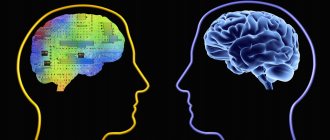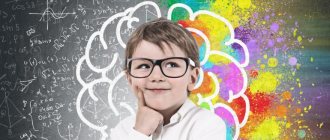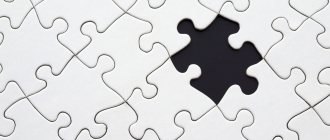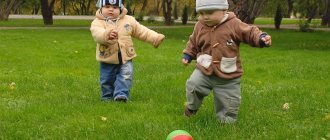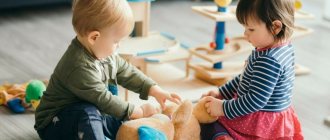One of the important features of a child in the future is the development of thinking today. It is important to start paying attention to this as early as possible.
There is such a thing as a “sensitive period”. This is the optimal stage for developing a particular skill. For children, the period when the foundation is laid is from 1 year to 7 years.
In the article we will talk about the stages of development of thinking in children, methods, and the connection of thinking with other skills.
Features of thinking in preschool age
The brain of a preschooler is mobile and malleable, open to new knowledge. That is why useful habits, the desire to engage in sports, music, theater and art are laid precisely in the preschool period.
In order for a child to analyze and think, it is necessary to constantly set new tasks for him, as well as modernize and complicate the skills he has already acquired.
There are several factors that have a strong influence on a child’s thinking:
- Circle of friends. The older the child, the more children and adults there should be around him. Kindergartens, clubs and sections help with this. The child must observe different behavior patterns of both adults and children.
- Speech development. The child learns to construct sentences and express his thoughts.
- Formation of an analytical worldview. Preschool children are characterized by paying attention to shapes, color, size, spatial arrangement and time frames.
- Acquiring skills and abilities. The child learns to retell, read syllables, and sing.
- Formation of personal qualities. Character, adaptability, initiative, organization - all this is formed as a result of educational activities.
- Formation of self-esteem. A developed child is able to evaluate himself.
- The emergence of self-control. The child learns to manage his behavior and actions.
Stages of development of thinking
- visually effective;
- visual-figurative;
- verbal-logical.
Visual and effective thinking is formed at the age of 1-3 years. When, as a result of his actions, a child, without realizing it, draws conclusions “for the future.” And proof of this are toys, keyboards, and parental gadgets disassembled for spare parts. The purpose of these actions is to know “what’s inside?”
At the age of 3-7 years, visual-figurative thinking is formed. It is during this period that the first signs of analysis appear. For example, having certain skills, a child can already tell what a toy will feel like when he sees it in a store window. Many can already predict the situation.
Closer to 6 years, the first inclinations of verbal and logical thinking appear. At this stage, the child begins to give detailed answers after analyzing information, is able to arrange the sequence of events in the correct order, and can characterize almost any object. Speech is of paramount importance on the development of a child’s thinking.
What it is?
If we rely on a specific definition, the term logical thinking comes from the words “logic” and “thinking.” In philosophy, logic is defined as a science that cognizes the laws of intellectual cognitive activity and has its premises in antiquity. She studies methods by which the truth can be discovered. Thinking is a mental process that allows you to process previously received information.
Thanks to correct and objective thinking, any of us has an idea about the world around us and the laws of nature.
If we combine logic and thinking, we get a certain process where logical constructs are used. When such a process is put into action, a person receives accurate objective knowledge and draws certain conclusions, including formal ones. In addition, logic is also involved in the creation of abstract concepts. When concepts are combined, then the information received is systematized. This process is unique to humans. Initially, a person receives abstract information and then connects it with each other. This is how logic, consisting of factors such as analysis and synthesis, is included in this process. To be more precise, analysis is the breakdown of information into separate parts. Through the process, our brain can determine the essence of information.
When synthesis is connected to analysis, the analyzed information parts are combined. This is exactly how logical thinking works in our minds. You need to understand: whoever knows how to think logically is able to carry out effective mental activity. Logical thinking is a special form of human intellectual activity. Let us consider the main stages that underlie the scientific, everyday, mythological and artistic knowledge of man.
What is it for
We constantly think, the brain does not stop activity for a second. A person processes tons of information every second, and in order to objectively assess what is happening, make the right decisions and make fewer mistakes, one must rely on logic. At first it will require effort, but then the brain will make the right decisions automatically because it will train.
These are not just single conclusions, but a chain of personal behavior, a way of life, part of individuality. The future depends on every decision, even if it seems insignificant. Having mastered the skill of thinking logically, a person is able to:
- choose a rational way to solve a life situation and find a way out;
- choose a quick and effective method to achieve your goals;
- calculate your competitors’ moves in advance, stay ahead and bypass them, anticipating every action;
- be able to conduct discussions, small talk, scientific debates and simply maintain a conversation;
- speak competently, concisely and understandably for everyone;
- draw conclusions based on your mistakes and become better every day, thanks to competent introspection and reflection;
- approach other people and yourself critically, soberly assess what is happening;
- master the art of oratory, influence other people by making compelling arguments;
- avoid outside manipulation, do not become a victim of deception and scams;
- be able to competently answer questions, twist the line of conversation in your favor, and not fall for the interlocutor’s tricks;
- do not succumb to self-deception and the Barnum effect - subjective confirmation based on a high assessment of the accuracy of the characteristics of your personality from generalized conclusions (horoscopes, tests, socionics).
Mental operations
Observing how a child’s thinking develops, the entire thought process can be divided into stages:
- comparison;
- analysis;
- synthesis;
- generalization.
At the comparison stage, the child learns to find the same in different things, different in the same. During this period, it is appropriate to give “find the differences” pictures and play memory games (start with 6 pairs of pictures, gradually increasing the number).
At the analysis stage, features, qualities, properties, materials and objects used are identified. In his imagination, a child can divide any product into its component parts.
The synthesis stage is closely related to the analysis stage. Without analysis it will not be possible to synthesize. An example of this is reading. Without remembering letters, without understanding how they merge into syllables, a child will not be able to read.
Vivid signs of generalization are the identification of common characteristics of objects and grouping. As soon as a child develops coherent speech and the use of a large number of generalizing concepts, you know that the generalization stage has begun.
Construction
Building games help develop motor skills, fine motor skills and creative thinking. Creating buildings according to diagrams and reproducing ideas in reality develops spatial and structural-logical thinking.
It would be nice to find time for joint activities with your child in this format. Using cubes you can create very entertaining tasks.
Lego can help you learn many math concepts.
Mathematics is very closely related to logic, so don't forget about math games for kids.
And, of course, the Tangram game perfectly develops children’s logical and spatial thinking.
A very interesting and useful book “Tangram in Riddles”.
All children are delighted with the amazing Möbius strip.
How to develop a preschooler's thinking
The development of thinking occurs through play, as this is the leading type of activity. You can beat everything. From a pedagogical point of view, it should be developed in different directions. Involve your child more in housework.
Check out the table; it contains the main types of exercises for developing thinking in children, which we focus on in our classes.
| Types of activities | Description |
| Memory development task | Memorizing image elements, sequence of details, etc. |
| Logic exercises | Find what is missing, identify a pattern using analysis, comparison, reasoning |
| Classification tasks | Sorting, grouping by characteristics, etc. |
| Exercises for concentration | Finding identical properties, differences between objects, images, etc. |
| Tasks for the development of spatial perception | Development of visualization, spatial arrangement, solving puzzles and puzzles |
| Exercise to develop analytical skills | Search for details that are superfluous or not true |
| Tasks for the formation of a strategic approach | Thinking through a whole chain of actions. Analysis of sequences and results |
Analogies
Tasks on finding semantic connections are difficult to complete for children with poorly developed logical thinking and a small vocabulary. At the same time, performing such exercises will help enrich the child’s vocabulary and develop logic.
How to do it? We need to identify the relationship between the first two words. Then find a similar connection in the second pair.
For example: Friday/Sunday, Tuesday/(Wednesday, Thursday, Saturday, Sunday)
Let's look at: "Friday - Sunday" what is the connection? These are the days of the week, going every other day. In the second pair, “Thursday” is suitable for the word “Tuesday”. He also comes the day after Tuesday.
Run / stand Scream / (Yell, yell, student, call, be silent)
Theater/ spectator Library/ (Listener, books, shelves, reader)
Iron / blacksmith Wood / (Table, cabinet, carpenter, board, plane)
Spruce / table Oak / (Wood, boards, cabinet, saw, sander)
Steamship/ pier Train/ (Conductor, rails, compartment, station, carriage)
Machine / motor Yacht / (Sea, sail, captain, deck, helmsman)
Eyes/ glasses Leg/ (Walking, shoes, crutch, bandage, socks)
Steam locomotive/ Horse carriages/ (Hoofs, cart, races, road)
Needle/point Razor/ (Barber, blade, beard, mustache, face)
Music/ orchestra Singing/ (Song, choir, music school, singer)
Cows/ herd Wolves/ (Attack, hunting, pack, grey, leader)
Rye/ field Apple tree/ (Apples, harvest, garden, gardener, juice)
Mountain / cave Tree / (Garden, hollow, forest, branches, trunk)
House/ floors Stairs/ (House, railings, steps, walk, rise)
Number/ numbers Word/ (Sheets, book, notebook, letters, reading)
Disease/ treatment Breakdown/ (Car, motor, repair, mechanic, car wash)
Cool/frost Blue/ (Blue, sky, purple, red)
Enemy/enemy Market/ (Buyer, bazaar, counters, sellers)
Raspberry/ berry Mathematics/ (Textbook, scientist, science, student, school)
Plant/ seed Duck/ (Bird, pond, ducklings, quacks, egg)
Year/ spring Life/ (Man, youth, long, cheerful)
Chapter/ book Apartment/ (New, balcony, three-room apartment, house)
Hunger/ lean Labor/ (Hard, tired, in the field, in the factory)
Film / Opera screen / (Curtain, theater, stage, artists, orchestra)
Monday/Tuesday Sunday/(Week, Monday, calendar, Saturday, day after tomorrow)
Tuesday/ Thursday Sunday/ (Wednesday, Tuesday, Friday, evening)
Morning/night Winter/ (Spring, autumn, year, summer, week)
Ball / circle Cube / (Figure, square, brick, constructor)
Goat / animal Bread / (stove, food, mold, dough, roll)
Voice/ echo Face/ (Reflection, mirror, clean, beautiful)
Exercises and games to develop thinking in preschoolers
Let's look at options for exercises and games that can be easily used in everyday life by the whole family.
Games for the development of visual and effective thinking
- “Sort into groups” is a game in which the work of the eyes and hands is leading. For example, place large spoons, dessert spoons and tea spoons in front of your child. Ask them to sort them. The child must decide for himself on what principle to do this.
- Game "Build a Row". Cylinder blocks, color plates, heat bottles, flavor bottles, tangram and other materials can be used here. For example, you need to build a row from large to small. Cylinder blocks from the Montessori method are used. Colored plates of the same color, but different shades, must be arranged from darkest to lightest.
- Game "Find a place for the nesting doll." It will require nesting dolls (at least 6 pieces). We arrange the figures in a row at an equal distance from each other. Then we ask the child to close his eyes, remove one figure, and align the rest. The baby opens his eyes and tries to find the place between which figures the matryoshka stood. As the task is completed, the number of components should increase.
Games for the development of visual-figurative thinking
- Game "What does it look like?" There are a lot of variations of it. One of them might be to show an image of a fancy blob. Give your child the opportunity to think about what it is, who it is, what it tastes like, what it smells like, what it does and other signs.
- Game “Say it in one word.” Depending on the age of the child, the approach to identifying objects will change. For children 3-4 years old - simple generalizations such as: furniture, dishes, berries, flowers. For a child aged 5 years, the generalization should be deeper, for example: insects, wild animals, pets, professions, etc. Children 6-7 years old already operate with such concepts as animals of Africa, Asia, fruits of Europe, Asia, etc.
- Game "Give a definition." The child is offered an object that he characterizes. For example, we show a mug that needs to be described: big, dad’s, fragile, glass, etc. And then the child shows you the object, and you characterize it.
Games for the development of verbal and logical thinking
- Game "Collect the picture." It is analogous to puzzles. The child’s task is to assemble a whole picture from several parts. The older the baby, the more details.
- Game "Continue the Row". Draw a chain and a row of beads in a certain sequence: yellow, green, blue, pink, and then repeat the row once and invite the child to continue. The older the child, the more beads there are, and their sizes change.
- "Opposites". A game of matching the opposite. For example, you say cold, but the child picks up hot; wet-dry; black and white and so on.
- Game "Guess what it's about." You consistently describe the subject, and the child guesses what you are talking about. For example: round, striped, sweet, juicy - watermelon.
Working with patterns
The pattern can be hidden in drawings, between numbers, letters, or any elements of a series.
To learn how to correctly find a pattern, we follow the following algorithm:
- We look carefully at a number of numbers, figures, animals, objects.
- Let's try to guess what the pattern is based on - what rule the elements are arranged according to.
- We are trying to determine the type of pattern.
- We test our assumptions one by one to see which rule holds.
- Having made sure that the “intended” rule is observed, we will be able to accurately name the next elements of the series.
Examples of patterns with numbers:
2, 5, 8, 11, 13, …
3, 4, 7, 8, 11, 12, …
99, 10, 88, 20, 77, …
4, 16, 5, 25, 6, …
Coloring books with logical patterns are perfect for children aged 5-9 years.
